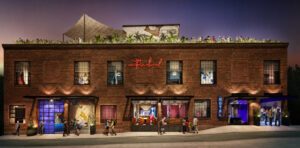ESG Investment
As the world races towards a sustainable future, the need for clean and renewable energy sources becomes increasingly vital. In this journey, biogas, bioenergy and renewable natural gas (RNG) are emerging as frontrunners, offering a promising solution to our energy demands. However, the path to widespread adoption requires support from various stakeholders, including tax equity investors. In this blog, we delve into the crucial role of tax equity in accelerating the energy transition and driving the advancement of biofuels. A Vision for the Future As we approach 2030, the energy transition takes center stage. Tax equity and tax credits have become instrumental in driving this transition by incentivizing investments in sustainable energy projects such as solar, carbon capture, electric vehicles (EV) and more. The involvement of tax equity investors is vital in providing financial support to biofuel developers, propelling the growth of biogas, bioenergy, and RNG projects. By channeling their investments strategically, tax equity investors play a pivotal role in shaping a greener and more sustainable future. Unveiling the Potential Biogas, biofuels, bioenergy, and RNG represent the pinnacle of sustainable energy solutions. Biogas is produced from organic waste and serves as a clean source of fuel. Biofuels are derived from renewable organic materials, providing a greener alternative to traditional fossil fuels. These fuels can be seamlessly integrated into existing infrastructure and engine technology, making them readily accessible for widespread adoption. In the quest for a sustainable future, these bio-based energy sources hold tremendous promise. Not only are biofuels compatible with existing infrastructure and engine technology, but they also offer near-to-long-term solutions that have a critical role to play. Tax equity investors facilitate the development of biofuel projects by providing the necessary funding and expertise. Their involvement enables biofuel developers to realize their visions, thereby accelerating the transition towards a sustainable…
Read MoreBattery energy storage systems (BESS) have received significant advancement in the United States due to the implementation of the Inflation Reduction Act (IRA), opening new opportunities for their development. This groundbreaking legislation introduces unprecedented economic benefits for standalone storage systems by making them eligible for a 30% investment tax credit (ITC), with the potential to increase to 70% through additional incentives. Historically, federal tax credits were only available for storage systems that were paired with renewable energy generation, such as solar power. However, the IRA has extended the eligibility of tax credits to standalone storage systems, which is anticipated to unleash a remarkable surge in storage investments. This landmark development holds immense potential, opening new avenues for investment and accelerating the transition towards a sustainable and reliable energy grid. Enhanced Investment Opportunities The IRA provides the investing environment with much needed certainty by extending the duration of ITCs. The increases and expansions of ITCs given through the IRA are now guaranteed through 2032 rather than being subject to temporary renewals. This more extensive timetable gives investors and developers the chance to strategically plan and maximize their returns. Additionally, the definition of project costs eligible for the tax credit has been expanded to include interconnection, microgrid controllers, and a broader range of components commonly used in clean energy systems. This can increase tax credit eligibility and accelerate project development. Leveraging Incentives Energy storage projects must adhere to labor standards in order to fully benefit from the tax incentives provided under the IRA. These criteria make sure that registered apprenticeship standards are followed and that prevailing salaries are paid. If a project satisfies these requirements, it may be further enhanced by three additional incentives: domestic content, energy communities, and low-medium income (LMI) initiatives. The domestic content incentive incentivizes the utilization of…
Read MoreThis blog is the third and final in a January 2023 series that will explore the opportunities in the transferability of renewable tax credits for investing in renewable energy and reducing tax liability. Consider reading the first and second blogs on this topic. The Inflation Reduction Act, signed into law on August 16, 2022, has created new opportunities to invest in a sustainable future. There are many options, but one of the more promising is new transfer provisions which allow for the transfer of renewable energy tax credits between taxpayers. With these new transfer provisions, a taxpayer can purchase a tax credit generated from an eligible project, for example, at $0.90 per $1 of tax credit and then apply the credit to reduce required tax payments to the Internal Revenue Service (IRS) by the full $1. In this blog, we’ll cover some of the considerations both investors and developers should keep in mind as they explore participating in the transferred tax credit market. The specific considerations we will explore are those associated with tax credit “step ups” on transferred ITCs, monetizing depreciation on transferred tax credit deals, recapture and eligible basis risk for transferred tax credits. Eligible basis risk and tax credit “step ups” Investment tax credits – whether a transferable or a traditional tax credit investment – are 30% (or more, if adders apply) of the eligible (cost) basis of the development of renewable energy development. What is allowed to be included in the eligible basis of a renewable energy development (e.g., solar system, battery storage facility, etc.) is subject to the rules of the IRS. In traditional tax equity transactions, it’s common for the project assets to be contributed into a holding company at a fair market value, thus establishing an eligible basis that is higher than the hard costs of the project. This fair market value is typically…
Read MoreDue to the risks posed by unsustainable practices, Environmental, Social, and Governance (ESG) analysis has gained increasing importance in the corporate world. This approach considers key stakeholders outside of shareholders during investment analysis, which helps investors protect against risks, capitalize on green opportunities, and attract ESG-conscious investors. By doing so, ESG analysis promotes stakeholder capitalism. In recent years, ESG-aligned investments have accelerated and outperformed the market. Environmental and social factors are among the top risks identified by the World Economic Forum, and double materiality makes ESG-aligned corporations best positioned for a low-carbon future. Governments can incentivize private investment in green industries through taxes and tax credits, which are an increasingly popular option as part of ESG strategies. Tax credit investments provide a market and revenue stream for renewable energy producing organizations, enabling them to align themselves with a sustainable, low-carbon economy and reduce their transition and liability risks and cost of capital while enhancing their ESG-credentials. Currently, ESG measurement and reporting space lacks a universal framework and consistency in terminology, data, and practices. The Taskforce on Climate-related Financial Disclosures (TCFD) framework and the EU Action Plan on Sustainable Finance aim to provide clarity and guidance on ESG and its incorporation into investment decisions, while the US Securities and Exchange Commission’s proposed disclosure rule will mandate public companies to report on their ESG impacts and seek assurance on that data from a third party. Companies that report and progress on ESG impacts and progress towards ESG goals are viewed as remaining competitive, while financial markets predict long-term benefits for returns. ESG-related disclosures are important as they provide stakeholders with the necessary data to analyze the material impacts of an organization. This enables companies to make smarter tax credit investment decisions and report the investments afterwards, meeting stakeholder expectations and enhancing their…
Read MoreFoss & Company 2022 project, Radical Hotel Many companies have long overlooked tax equity investing as part of their tax strategy for different reasons. But this past year has presented new, unique opportunities in the tax equity market for both developers and investors. The Inflation Reduction Act (IRA) has provided more incentives than ever in US history for tax credit investments and facing the current challenge of inflation and increasing interest rates, tax equity may be essential to push projects forward. 2022 proved to be a big year for Foss & Company as well. In June, Foss announced that in addition to the over $8 billion in tax equity the company has deployed since its inception, we have over $1 billion in tax credits currently under management. Among other milestones, the Foss & Company team has continued to grow. We welcomed 14 new team members who have helped grow our capital markets, renewable energy, marketing and real estate teams. We are also pleased to share that in August of 2022, Foss & Company featured North Carolina project, Capitola Mill, won the Gertrude S. Carraway Award for demonstrating a commitment to extraordinary leadership, research, philanthropy, promotion, and/ or significance in preservation. We could not be more thrilled with our successes in 2022, and we could not have done it without our dedicated team, developer partners and investor clients. Vision 2045: A Look Towards the Future In 2022, Foss & Company had the unique opportunity to be featured in the Vision 2045 campaign. This campaign supported the United Nations and its objectives for the institution’s 100- year anniversary in 2045 and aimed to inspire businesses and people to take collective action to ensure a better future for all. As part of this multi-faceted campaign, Foss & Company produced a short, documentary-style video that highlighted…
Read MoreFoss & Company is comprised of a group of experienced professionals, representing the best in class within their respective fields. In this blog series, we highlight different Foss & Company team members to shine a light on the diverse and dedicated people that help make us who we are. Drew Goldman, Vice President of Investments for Foss & Company, spent 18 years in financial services and held roles including equity syndication, strategic M&A, global investment banking, corporate lending, and commercial real estate before joining Foss & Company in 2019. Drew has an MBA from Emory University’s Goizueta Business School and earned his BBA from The University of Texas at Austin. Get to know Drew in the latest Spotlight Series blog: How did you get started in the tax credit investing industry? After working in the corporate finance and investment banking industries, I moved “back home” to Atlanta in 2005 and found myself in charge of business development for an apartment management company; a large portion of the third-party units were in the Low-Income Housing sector, so I learned a lot about tax credits by absorption. With 2008 – and the “Great Recession” an opportunity to raise capital for a large LIHTC syndicator presented itself. I then transitioned into tax equity. Since then, I have migrated from Housing into Renewable Energy and Historic Preservation. When did you join Foss & Company and what interested you about the company? I joined Foss in January 2019 with a growing interest in financing Renewable Energy and other Sustainability-focused initiatives. Foss has a highly entrepreneurial culture, and a flexible approach to our evolving marketplace. What do you find important or interesting about tax credits? I have been in financial services since the 1990s – tax credit equity is well-proven for mobilizing private sector capital into…
Read MoreIn November, Foss & Company Managing Director Bryen Alperin and Associate Vice President of Renewable Energy Investment Operations Annie Amrhein travelled to Sharm-El-Sheikh, Egypt to join business leaders from around the world in sharing best-practices that promote the United Nation’s Sustainable Development Goals (SDGs) within their organizations. We have included their reflections from the conference below: Climate change is a global problem. What insights did you gain through the lens of a global assembly of leaders and experts that differ from US-focused events? One major reflection I took away from this type of global assembly is how climate change, associated impacts, and overall management of these impacts, has no bounds. There were so many different industry players present from product manufacturing to electric vehicles to real estate management to professional sports to public officials. This varied representation was significant and showcased quite clearly how climate change issues are not contained nor confined to one sector. I think where there is variation is how companies and industry players are choosing to enact sustainable solutions. Although the underlying goal may be the same, due to the nature of a company’s core mission, revenue stream, position within the market, etc., these differing factors influence how decision-makers not only develop but ultimately implement within their given business structures. Throughout discussions, what were some general consensuses between global leaders and experts concerning sustainability? What were some of the biggest differences in perspectives? The conference showed evidence that the “sustainability and environmental initiatives are bad for business” argument no longer holds merit. In fact, I think the opposite is now the case of if a business representative is unable to speak to what the company is taking to decarbonize infrastructure, minimize waste, promote sustainable measures throughout its employee base, then it may result in negative business…
Read MoreIncentives for renewable energy have been a hot topic in the U.S. lately, especially with new provisions geared towards implementing recently developed technologies that aim to fight climate change. The Inflation Reduction Act (IRA), signed into law in August of this year, contained significant adjustments to several climate and sustainability solution incentives. Widely regarded as landmark legislation, it was one of the most extensive environmental policies in decades. It laid the groundwork for incremental change through increases in tax credit incentives for projects like Carbon Capture, Utilization and Sequestration (CCUS), battery storage, and solar Investment Tax Credits (ITCs). Under the IRA, institutional investors may now see higher tax credit returns on their investment and new opportunities through ITC adders. The U.N.’s Sustainable Development Goals (SDGs) offer a blueprint to achieve a better and more sustainable future for all. They address the global challenges we face, including poverty, inequality, climate, environmental degradation, prosperity, and peace and justice. No one action can address all 17 goals at once but using the SDGs as guidelines can help inform corporations of processes that can help tackle some of the most pressing issues of our time. The adjustments made to policies under the IRA align in many ways with the SDGs including those made to solar ITCs. ITCs are calculated as a percentage of the cost that solar developers spend on solar power production equipment while constructing a project. Before the IRA, ITCs were set to reach 10% by 2024, but under the IRA, they now have a base rate of 30% locked in for the next ten years. The law also includes certain adders that can increase the total amount to 60%. The increased incentives can help move solar projects forward despite the recent high interest and inflation rates. These adders include, but are not limited to: 10% for projects located…
Read MoreCarbon Capture, Utilization and Sequestration (CCUS) is the process of capturing carbon oxide (can be either carbon monoxide or carbon dioxide, but most commonly we speak of carbon dioxide or CO2) from emission sources for the purpose of preventing it from reaching the atmosphere, which would amplify greenhouse heating. Typically, the CO2 is permanently stored deep underground, but it can also be utilized in other ways, so long as the CO2 never reaches the atmosphere. CCUS and the related 45Q tax credit provides a unique opportunity for tax equity investors to invest in an Environmental, Societal, and Governance (ESG) friendly tax credit. The process of CCUS typically involves the following steps: Locate a predictable and constant source of carbon dioxide emissions: Most combustion processes create CO2, a few examples are coal/natural gas plants, power plants, and ethanol production. Capture the CO2: The process involved in capturing the CO2 depends on the concentration or purity levels of the source emissions. High purity emissions of CO2 (>95% by volume), such as the CO2 emitted from the biorefining of ethanol requires minimal, off-the-shelf-technology to separate out the CO2. Low purity emissions (<95% by volume), such as the CO2 emitted from a coal power plant require advanced technology and various chemical processes to separate out the CO2. Find storage site: A suitable storage site is required to permanently sequester the CO2. Currently, the most suitable sites may be a saline aquifer or in a depleted oil reservoir as is the case in enhanced oil recovery (EOR). Other means of permanent storage are being pursued, for example permanent sequestration in concrete during the manufacturing process. Transfer the CO2 to the sequestration site: In some instances, producers (emitters) of CO2 may be conveniently located on or near a suitable storage site. In all other instances, pipelines are used to transport the CO2 from the emitters to the…
Read MoreBY DREW GOLDMAN, VP OF INVESTMENTS Every year, many sophisticated corporations divert over $20 billion of federal tax payments into projects in renewable energy, affordable housing, and historic preservation, in exchange for tax breaks and investment benefits. Some perceive a significant level of complication in these programs, and therefore delay taking a closer look. The very word ‘investment’ moves many people outside their comfort zones. As a manager of funds delivering Renewable Energy Tax Credits (Sec. 48 of the Internal Revenue Code), Foss & Company is in the business of making it easy to take advantage of this high-impact federal tax incentive. ITC (investment tax credit) Funds provide a well-defined system for dealing with project and developer selection, project structuring, negotiation and closing, as well as potential tax benefit delivery including: Determining project eligibility and focusing on any hurdles to placing site(s) into service Structuring the transaction to address developer and investor needs Underwriting the developer, underlying power purchase contract and pro forma operations Valuing and appropriately pricing tax credits and other projected benefits Delivering Tax documents and financial reporting for annual federal filings In terms of physical asset protection, potential losses at a solar farm typically to fall into two categories: ‘Acts of God’– fire, floods, earthquakes, or storms that damage the array or interrupting operations; and ‘Acts of Man’ – such as terrorism, a vehicle or plane crash, negligent maintenance, or faulty equipment. These risks can be insured against potential losses. One risk typically not covered in conventional policies is fraud. Foss & Company conducts due diligence and background checks on each developer and its principals prior to closing any project. The lender and the long-term power buyer (typically a utility, municipality, or large corporation) conduct their own independent evaluations as well. Recapture Risk – The full value of…
Read More








